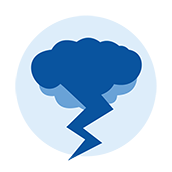Learn about stormsHe ako mō te āwhā
 New Zealand often gets hit by storms as it lies in the ‘Roaring Forties’. This is where mild air temperatures from the north meet cooler air from the south. Learn about storms in New Zealand.
New Zealand often gets hit by storms as it lies in the ‘Roaring Forties’. This is where mild air temperatures from the north meet cooler air from the south. Learn about storms in New Zealand.
On this page
What is a storm?
Storms can cause strong winds, rain, thunder, lightning, hail, heavy snow and rough seas. MetService issues strong wind warning when they expect winds more than 87 kilometres per hour over land.
Tropical cyclones are large revolving storms that develop in the tropics. They are also called hurricanes or typhoons. They have a wind-speed of more than 120kph.
Tropical cyclones usually weaken when they meet the cooler sea temperatures around New Zealand, But sometimes they can cause major damage. In 1988, Cyclone Bola caused more than $200 million in damage, even though it was no longer a tropical cyclone by the time it reached our shores.
Storms can destroy roads, railways, bridges and buildings. They can ruin crops and kill livestock. At sea, ships are at risk (the ferry Wahine sank during Cyclone Giselle in 1968, with the loss of 51 lives). Dangers from storms include:
- fallen trees and poles
- torn-off roofs
- fast-flowing currents in streams and rivers
- flying objects
- landslides, and
Coastal areas can suffer from storm surges. Storm surges are extra-high waves caused by low pressure in the air above the sea that causes the sea-level to rise.
What do we do before a storm?
- Listen to the radio for information.
- Bring pets inside.
- Clear away anything outside that may fly around in the wind.
- Put tape across large windows to prevent them from shattering.
- Close all windows.
What do we do during a storm?
- Stay inside and bring your pets inside. If you have to leave, take them with you.
- Close all curtains and stay away from doors and windows.
- Open a window on the side of the building away from the wind — this will lessen pressure on the roof.
- Stay away from metal and electrical fixtures.
- Listen to the radio and follow the instructions of emergency services.
What do we do after a storm?
- Stay indoors and listen to the radio.
- Avoid dangling and broken power lines.
Find out more about what to do before, during and after a storm.
Home learning

Make a plan with your family to get through an emergency. Think about the things you need every day and work out what you would do if you didn't have them.
Make your plan — print it out, stick it on the fridge and make sure everyone knows the plan.
Find out about past storms that have happened in your region.
Find out more by reading online. Choose one of these resources to email to a friend or family member.

Read a New Zealand perspective on severe weather on Te Ara, The Encyclopedia of New Zealand.
Learning resources

See huge storms, heavy rain, tornadoes and other exteme conditions in these videos from Science Kids.
Learn about emergencies
Natural hazards can be frightening. They can strike at any time and often without warning. Explore the types of emergencies below and learn better ways to prepare.






